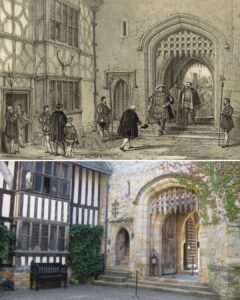Introduction: A Castle Steeped in History
Hever Castle, a picturesque stronghold nestled in the Kent countryside, holds a prominent place in English history. Though it started as a modest family residence in the 13th century, it gained renown as the childhood home of Anne Boleyn, the woman who would go on to change the course of England. In the 19th century, artist Joseph Nash immortalized the moment when King Henry VIII arrived at Hever Castle in one of his engravings, allowing us to glimpse the Tudor grandeur of the castle in contrast with its current appearance. Today, Hever Castle stands as a testament to a royal saga that reshaped a nation.

1. The Origins and Early History of Hever Castle
Originally built in 1270, Hever Castle served as a defensive fortress for much of its early history, its stone walls and battlements constructed to protect against potential invaders. Over the centuries, it evolved from a medieval stronghold to a comfortable family estate. By the 15th century, the castle had passed into the hands of the Boleyn family, who added the Tudor-style wings that we still see today. This transformation from a military fortification to a stately home made Hever Castle a desirable residence for the English gentry and set the stage for its role in one of the nation’s most dramatic historical episodes.
2. Anne Boleyn’s Early Life at Hever Castle
Anne Boleyn spent much of her youth at Hever Castle, where she received an education fitting for a young noblewoman of her time. Educated in courtly manners, literature, and languages, Anne’s upbringing prepared her for a potential position within the English aristocracy. However, her destiny would take a fateful turn when her wit, charm, and intelligence caught the eye of King Henry VIII.
The king’s infatuation with Anne, who resisted his advances until he promised marriage, ultimately led to England’s split from the Roman Catholic Church. In seeking to annul his marriage to Catherine of Aragon, Henry VIII initiated a series of religious and political reforms known as the English Reformation. Anne’s childhood home thus became the focal point of a royal scandal that would change the face of English history forever.
3. Joseph Nash’s 19th-Century Engraving of Hever Castle
In the 1800s, Hever Castle’s historical significance attracted the attention of artists like Joseph Nash, a British painter and lithographer known for his romanticized engravings of historic buildings. Nash’s depiction of Henry VIII’s arrival at Hever Castle captures a moment of regal splendor, showing the king with his retinue as they approach the castle gates. The engraving highlights the Tudor architecture and grandiosity of the castle as it might have appeared in the 16th century, with details that evoke the era’s opulence and grandeur.
This engraving serves as a historical artifact, giving modern viewers a glimpse of what the castle might have looked like during Anne Boleyn’s lifetime. It invites comparisons with the present-day structure, which has seen various renovations while preserving the integrity of its Tudor design.
4. Hever Castle Today: Preservation and Modern Renovations
Today, Hever Castle remains a beautifully preserved historic site, maintained for public exploration. Since the early 20th century, a series of restoration efforts have revitalized the castle and its surrounding grounds. William Waldorf Astor, an American millionaire, purchased Hever Castle in 1903, overseeing extensive restorations that included the addition of stunning gardens, a moat, and a lake. Astor’s renovations honored the castle’s Tudor character while enhancing it as a public attraction.
Walking through the castle today, visitors encounter Anne Boleyn’s bedchamber, the Tudor Hall, and a range of Tudor-era artifacts that allow them to step back in time. The surrounding gardens, designed in an Italianate style, include a Tudor Garden, a yew maze, and fountains that contribute to the castle’s enchanting atmosphere.

5. The Legacy of Anne Boleyn and Henry VIII
The relationship between Anne Boleyn and Henry VIII left a profound mark on English history. Their union, despite ending in tragedy for Anne, shaped the future of the English monarchy and set the stage for the rise of the Anglican Church. By challenging the Pope’s authority and establishing himself as the head of the Church of England, Henry changed the nation’s religious landscape forever.
Anne Boleyn’s legacy endures at Hever Castle, where her story remains central to its allure. Her portrait, along with other Tudor relics, is displayed in the castle, reminding visitors of the ambitious woman whose love affair with a king sparked an era of radical reform. For many, Hever Castle stands as a symbol of love, ambition, and the often tumultuous nature of power.
Conclusion: Hever Castle as a Living Monument to Tudor History
Hever Castle today offers visitors an immersive experience into England’s Tudor past. From Joseph Nash’s 19th-century engraving to the modern preservation of its architecture and grounds, the castle embodies a blend of historic authenticity and artistic homage. As the former home of Anne Boleyn, it remains a place where history and romance intertwine, capturing the spirit of a bygone era that reshaped the nation.
